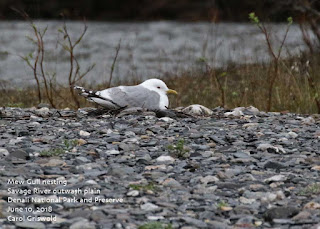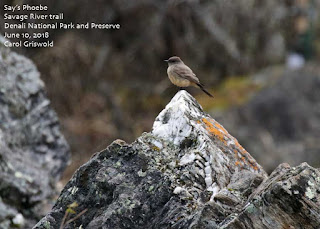Sunday, June 10: Rain surrounded us for most of the final day of class, with short, drier periods. Rather than a soggy hike, we birded along the Park Road heading west. We checked out the scrubby willow area again, walking to the creek and hoping for an Arctic Warbler, but it was much quieter today.
High on a nearby brooding mountain, at least a dozen white Dall sheep including a lamb, ran in a line along a barren ridge and across a steep slope. We wondered what caused such panic while admiring their ability to traverse the treacherous terrain so effortlessly.
A GOLDEN EAGLE soared overhead; under such bad lighting, the distinguishing characteristics of a small head and long tail differentiated it from the much larger-headed Bald Eagle.
We stopped to check the Raven nest on the bridge again, and watched the single adult scavenge and feed the five begging babies.
I heard an emphatic, “Eeenk!” nearby and eased away to check a talus slope by the road. Yes! A Collared Pika, sitting on a rock, a living Beanie-Baby, so cute! The tiny rabbit-relation leisurely scratched an itch, then plucked a nearby plant to add to its stash of dried grasses and flowers. Pikas do not hibernate and must rely on a large supply of stored food to get through the long, cold winter. It was such a pleasure to watch one from above, so close. It seemed more alert to danger from below than above so we paparazzi caused no alarm.
Incidentally, Katie found a soccer ball hacky sack wedged into the rocks of the Pika’s territory. It was an odd discovery; could someone have lost it while waiting for the shuttle bus? Did the Pika care? Retrieval would have been too disruptive, so there it will stay. Until Raven finds it!
As the rain rattled on the roof and dark clouds loomed to the west, we headed back east to Savage River at mile 15 where the sky appeared lighter. A helpful sign on the bridge noted the elevation as 2780 feet. Many vehicles were parked in the parking lots on both sides of the river as this is the farthest private vehicles can drive on the park road without a road permit.
Within minutes of hopping out of the van, we spotted a SAY’S PHOEBE flycatching from scraggly willow and driftwood perches on the gravel outwash plain. This bird had been reported on the Boreal Birder website a few weeks ago, and I was hoping for a chance to find it. LIFE BIRD! Yay!
A HERRING GULL sat quietly on her substantial stick, grass, and moss nest built on the gravel bar; a MEW GULL nested nearby. It was a great comparison: the Mew Gull was much smaller with a thinner bill. Another Mew Gull perched on top of the van gave a great view of its yellowish legs. The bulkier Herring Gull has pink legs. A very protective Mew Gull repeatedly dive-bombed a puppy on a leash, fairly far from any nest, ignoring all the people. It was likely the first scary thing that has happened to that little pup!
As we slowly walked along the 2-mile loop trail, we birded and botanized. A majestic Dall sheep ram surveyed his kingdom from high on a nearby mountain saddle. A SAVANNAH SPARROW sang from the dense willow brush along the trail. Also heard/seen was an AMERICAN TREE SPARROW, LINCOLN’S SPARROW, and WHITE-CROWNED SPARROW. Great habitat for sparrows!
A very handsome male WILLOW PTARMIGAN plucked tidbits from the ground near the trail, still molting into summer plumage like the rest of the many willow ptarmigan we had seen along the road. It was so great to get such a good view of the Alaska state bird, one that is often hard to find.
As we neared the end of the loop, the Say’s Phoebe landed on the lichen-covered rocks. A White-crowned Sparrow aggressively chased it off, perhaps guarding a nest nearby. The Phoebe flew to another rocky area where a second Phoebe suddenly appeared! I wonder if they are a pair and perhaps nesting, or rivals?
A Raven landed on the remarkable rock spire that resembled a sheep head (or a monkey with ears). It held a vole firmly in its beak, and after a short rest flew off, presumably to feed its hungry babies.
Despite this trail’s easy access, negligible elevation gain and popularity, the birds, wildlife, and flowers are amazing and one (I) could spend hours here.
Our final mini-field trip was a short walk at the Mountain Vista Trail. Nice views of very dark rain clouds all around! The highlight here was old wolf scat along the trail and the beautiful willow flowers. The rain soon drove us back to the van, making us really appreciate all the gaps in the rain we enjoyed this weekend.
On the way back to the parking lot, we saw a bull moose strolling parallel to the road, browsing on fresh new leaves; just missed a brown bear recently sighted at the restroom stop; collected and disposed of an old, very soggy and nasty diaper flung into the alders (Yuk! How could anyone DO that in such a beautiful place and yards away from a dozen trash cans???) We also added a new bird, a male BUFFLEHEAD swimming solo on a small pond. Hopefully his mate is incubating her eggs in a tree cavity nearby.
The rain slackened as we unloaded the van, said our good-byes, and scattered. Morgan kindly dropped Katie and I off at the Wilderness Access Center (WAC) where we met the hostel shuttle bus in a downpour. A cold front moved in that night bringing fresh snow to the surrounding mountains; nice to be warm and dry inside!
This is a well-designed trail with an extensive set of gravel and wood steps leading down to the lake. A nice, wide boardwalk with easy ramps on both ends winds through the forest, then the trail leads around the lake.
TREE SWALLOWS swooped over the calm lake. Beaver-felled spruce were strewn near the lake; it appeared some of the trees were too big for the beavers to carry and so just lay where they fell. Several enormous beaver lodges, likely homes for generations of beavers anchored the peninsula shore. If the large and final beaver dam at the outlet to the lake ever failed, it would be catastrophic for this lake ecosystem. The brown, churning Nenana River surged past in furious contrast to the tranquil lake.
We spotted yet another moose browsing on the willows and stepped up our pace to get clear. It sure is different seeing moose when you are right on the ground with them!

We hoofed it back up the trail stairs and down the path to the train depot, arriving in plenty of time. When the train arrived at noon, we enjoyed the ride south, listening again to the Northern Waterthrushes at the stops, watched two SANDHILL CRANES flushed by the train’s passing, heard the Olive-sided Flycatcher and Fox Sparrow at Talkeetna, and saw the Osprey nest by Wasilla (no birds were seen this time).
Early spring evolved into summer with every mile. The snow patches along the northern rails disappeared. The dense understory of Ostrich ferns around Talkeetna were incredible. Then everything was green, green, green and in full leaf. In the short time we were away, wild roses and elderberry along the tracks had burst into bloom. What a fabulous trip to Denali National Park and Preserve, and journey through time and seasons.
An excellent plant resource is the Ecological Atlas of Denali’s Flora at
There are many excellent bird identification apps for smart phones:
I like iBird Pro, $15, but there are other wonderful, free apps like the Audubon Bird Guide app. Check out this review of bird apps at
Happy travels and happy birding!
Carol Griswold
Seward Sporadic Bird Report Reporter
Trip bird list:
From class:
Bufflehead
Willow Ptarmigan
Rock Ptarmigan
Northern Harrier
Golden Eagle
Gyrfalcon
Mew Gull
Herring Gull
Northern Hawk Owl (only seen by one person in camp, not me)
Say’s Phoebe
Northen Shrike (did not see from van)
Gray Jay
Black-billed Magpie
Common Raven
Boreal Chickadee
Swainson’s Thrush
Hermit Thrush
American Robin
Varied Thrush
Orange-crowned Warbler
Yellow-rumped Warbler
Wilson’s Warbler
American Tree Sparrow
Savannah Sparrow
Fox Sparrow
Lincoln’s Sparrow
White-crowned Sparrow
Golden-crowned Sparrow
Dark-eyed Junco
Common Redpoll
Add:
Tree Swallow from Horseshoe Lake Trail
Additonal species seen/heard from train:
Trumpeter Swan
Mallard
Osprey
Sandhill Crane
Olive-sided Flycatcher













































No comments:
Post a Comment